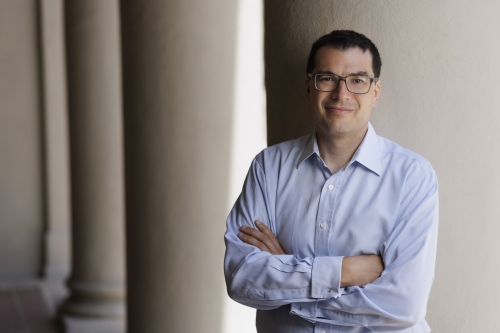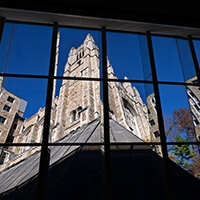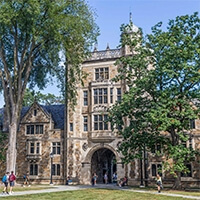In its June 27 decision in Trump v. CASA, the US Supreme Court limited the scope of federal courts to block presidential policies nationwide. The issue before the justices was whether federal courts in three cases could issue universal injunctions against President Trump’s Executive Order 14160 limiting birthright citizenship. The majority opinion by Justice Amy Coney Barrett did not address the merits of the birthright citizenship order.
The 6-3 decision comes in response to the consolidated cases of Trump v. CASA, Trump v. Washington, and Trump v. New Jersey. The Trump administration came to the Supreme Court on its emergency docket, asking the justices to allow it to implement its order. Oral arguments were heard in May.
Kristin Collins, the James E. and Sarah A. Degan Professor of Law, co-authored an amicus brief that was filed in the Fourth Circuit Court of Appeals, CASA v. Trump. Sam Erman, ’07, professor of law and co-director of the Program in Race, Law, and History, has also written on Trump’s views on birthright citizenship.
Read further for their insights into the Supreme Court’s decision.
1. Were you surprised by anything in the court’s decision?

Justice Amy Coney Barrett’s majority opinion holds that a lower federal court may not grant injunctive relief that is “broader than necessary to provide complete relief” to the plaintiffs before the court. As a general matter, then, the lower federal courts may not “universally enjoin” a federal law or policy. It was unsurprising that the Supreme Court reined in the federal courts’ use of universal injunctions, as they have been under the microscope for many years. Critics have asserted that universal injunctions exceed the federal courts’ equity powers, that they short circuit the process of percolation of legal issues in different federal courts, and that they incentivize plaintiffs to forum shop for the district court most likely to be amenable to their case.

The timing of this case is also unsurprising. Federal courts have issued universal injunctions staying enforcement of policies and orders promulgated by presidents of both parties. However, there have been more universal injunctions issued during President Trump’s first and second terms than during Presidents Bush’s, Obama’s, and Biden’s terms combined. Thus, the Trump administration had a significant incentive to challenge their legality.
Moreover, given the current composition of the Supreme Court and the general direction of its equity jurisprudence in the last 25 years, it is unsurprising that a majority of the justices voted to substantially curtail—if not largely eliminate—the use of universal injunctions going forward.
In a 1999 case called Grupo Mexicano de Desarrollo v. Alliance Bond Fund, the Supreme Court announced an originalist test for determining the scope of federal courts’ equity powers. Grupo held that the only equitable remedies available in federal court are those remedies that were traditionally available in “courts of equity” at the time of the nation’s founding. Whether the standards of equity practice in 1789 should provide the metric for determining the scope of modern federal courts’ remedial authority is a much-debated question.
The CASA court’s account of the history of federal equity practice as it relates to universal injunctions is also open to dispute. But students of the federal courts’ equity jurisprudence will not be surprised by the majority’s methodology. Nor will they be surprised that, in this Supreme Court’s hands, that originalist approach led to a significant reduction in federal equity power.
What is surprising is just how far Justice Barrett’s majority opinion appears to go. A different Supreme Court—or a different majority—might have taken a more moderate approach and used CASA to narrow the availability of universal injunctions while also providing guidelines regarding when they are warranted. For example, the justices could have required federal courts to hold a special hearing on a plaintiff’s request for a universal injunction. They also could have limited the availability of universal injunctions to situations where uniform relief is particularly warranted given the nature of the challenged policy. A case involving denial of birthright citizenship seems like an especially good candidate for a uniform remedy given that citizenship is a national status and uniformity is one of the central qualities of American citizenship. Instead of directing and constraining the use of universal injunctions, the Supreme Court threw the baby out with the bathwater.
2. What effect will the Supreme Court’s decision have on universal injunctions, and how will it change the current practice of federal courts using injunctions to block federal policies and plaintiffs’ tendency to engage in “forum shopping”?
In CASA, the Supreme Court significantly restricted the power of lower federal courts to issue injunctions that protect the interests and rights of nonparties. This means it will be more difficult for federal courts to prevent the federal government from enforcing unlawful (or likely unlawful) laws and policies, like President Trump’s birthright citizenship executive order.
However, the contours of CASA’s prohibition on universal injunctions are not entirely clear. As noted, the opinion says that a federal injunction may do no more than is required to provide complete relief to the parties before the federal court. However, it does not say that an injunction may never benefit a nonparty. There will be disagreement—among parties and among lower federal court judges—as to how to apply that standard. What if “complete relief” to the plaintiffs before the federal court requires a universal injunction? Justice Barrett’s CASA opinion—and the remand to the lower courts to “determine whether a narrower injunction is appropriate”—suggests that equitable relief that operates like a universal injunction may be permissible in some cases.
In addition, the majority and concurring opinions identify two other tools that might permit a federal court to issue an injunction (or a similar remedy) that protects the rights of parties not directly before the court: Federal Rule of Civil Procedure 23, which provides the criteria for certifying class actions, and the Administrative Procedure Act (APA). One can expect that plaintiffs will file more class actions and will bring more challenges under the APA. Exactly how those cases will play out remains to be seen, but it is noteworthy that in the last two decades the Supreme Court has interpreted Rule 23 narrowly. After CASA, we should expect more disagreement over the certification standards for nationwide class actions and over the kinds of remedies permitted under the APA.
CASA may help cure some of the problems associated with universal injunctions. For example, it does seem likely that CASA will result in more lawsuits being filed on the same legal issue, and thus more federal courts will have the opportunity to assess the legality of executive orders and federal laws and regulations that appear to run afoul of the Constitution. At least in theory, the Supreme Court will have the benefit of their opinions. Will CASA reduce forum shopping—that is, plaintiffs’ practice of filing suit in the federal venue that they believe most likely to rule in their favor? Perhaps. But parties engage in forum shopping for many reasons, so it is not clear that this decision will appreciably reduce that practice.
3. What are the immediate implications of the Supreme Court’s decision for the three cases in the lower courts?
President Trump’s executive order declares that people born more than 30 days after its effective date will be subject to its restrictions on birthright citizenship. The Supreme Court’s decision restarts that clock. But nothing in any of the justices’ opinions suggests that the three lower courts were wrong in presuming that the substantive merits are strongly against the administration. Hence, we can expect that all three lower courts will be issuing new injunctions shortly. The key question will be how broad those injunctions will be.
In deciding how to proceed, the courts below face different types of litigants. One set includes individual expecting parents who sought injunctions to protect their soon-to-be-born children. We can expect the lower courts to issue new injunctions that cover those individual plaintiffs. Another set of litigants is a group of states that sued in their own right. Among the injuries that the states have asserted is harm caused by state-by-state variation in the rules concerning birthright citizenship. Therefore, they contend that “complete relief” for them requires a universal injunction. The lower courts will have to decide whether they agree, and also whether states are the proper party to complain about a denial of citizenship to individuals.
The Supreme Court’s decision will also prompt the filing of new cases. One reason is that the justices in the majority imply that the class action may be the proper tool for achieving comprehensive relief. To that end, a national class-action case has already been filed. Other class actions based on differing criteria may follow.
In the meantime, there is also likely to be a flood of lawsuits by individual expecting parents seeking injunctions to prevent their soon-to-be-born children from being deprived of the benefits of citizenship.
Slightly further down the road, we can expect the government to begin promulgating policies for implementing the executive order. Many of those policies will be agency actions that can and will be challenged pursuant to the APA, which bars agency actions that are contrary to constitutional or statutory law.
4. The Supreme Court did not weigh in on the merits of President Trump’s executive order. When do you think that issue will come before the justices, and what happens to children born in this country between now and when they make a decision? For example, will there be children who become citizens in the jurisdictions where there are injunctions and others who do not in the other jurisdictions?
It is highly likely that the Supreme Court will accept a case on the substantive question of birthright citizenship in the fall and issue a decision by this time next year.
What will happen in the interim is very much up in the air. As noted, the variables include what litigation is brought, how district courts apply the Supreme Court’s new standard, and how the courts of appeals and the Supreme Court respond to district court decisions pending the Supreme Court’s resolution of the underlying merits. It is possible that a better-justified universal injunction or one or more class-action decisions may completely stop the executive order from coming into effect before the Supreme Court’s ruling on the merits. If not, some newborns will receive the benefits of interim relief and others will not.
5. Professor Erman, you’ve written about President Trump’s views on birthright citizenship as far back as his first term. What is his argument for ending birthright citizenship, and why do you disagree?
The Trump administration’s view is inconsistent with history, precedent, practice, and text. The citizenship clause of the Fourteenth Amendment is a sweeping guarantee of US citizenship to “All persons born…in the United States, and subject to the jurisdiction thereof.” The rule itself is substantially older than the Fourteenth Amendment, stretching back to the nation’s founding and before. Millions of Americans whose immigrant ancestors happened not to naturalize owe their citizenship to the Fourteenth Amendment and the approach that it codified.
Officials in the Trump administration argue that the broad constitutional guarantee of birthplace-based citizenship ought to be transformed into a descent-based rule. They would exclude from birthright citizenship all people lacking a parent who is either a US citizen or a US legal permanent resident. They seek authority for that view in the citizenship clause’s narrow exception to birthplace-based citizenship for people born not “subject to the jurisdiction” of the United States.
But as the framers of the Fourteenth Amendment and the Supreme Court both made clear, that exception covers only a closed set of longstanding historical carveouts to the rule, such as children of ambassadors, children of occupying soldiers, and Indians who were members of tribes. The general, overwhelming, and oft-repeated rule since the founding has been that US-born children of foreign parents are US citizens.
6. Professor Collins, you’ve written that, while judges who have considered President Trump’s executive order have focused on the 14th Amendment, that order also violates the federal birthright citizenship statute. Can you explain why the courts don’t need to address the constitutional question?
Thus far, all of the federal judges who have written opinions concerning the legality of Executive Order 14160 have concluded that the order is unlawful because it violates the Fourteenth Amendment’s citizenship clause. Those opinions are correct. However, as Justice Sotomayor observes in her dissent in CASA, there is another reason why the order is unlawful: It violates a federal statute, 8 U.S.C. s. 1401.
In an amicus brief I co-authored with professors Gerald Neuman (Harvard Law School) and Rachel Rosenbloom (Northeastern Law School), we elaborated this argument for the courts. Section 1401 provides that “a person born in the United States, and subject to the jurisdiction thereof,” is a US citizen at birth. Although the wording of Section 1401 is nearly identical to the citizenship clause, that statute provides an independent source of citizenship for children born in the United States. Section 1401 was first enacted as part of the 1940 Nationality Act and was later incorporated into the 1952 Immigration and Nationality Act. Under the traditional rules of statutory interpretation, the meaning of that statute should be taken from the statute’s text and the intention of the legislators who drafted and voted on the statute.
We have unearthed a significant paper trail demonstrating that when Congress enacted Section 1401, it understood that statute to be a near-universal statutory guarantee of birthright citizenship for children born in the United States. Without question, mid-20th century legislators understood that the birthright citizenship statute extended to the two groups that Executive Order 14160 would exclude from birthright citizenship: the US-born children of temporary visitors and those of unauthorized immigrants. Because the order violates a duly enacted statute, it is unlawful and unenforceable for that reason alone.







